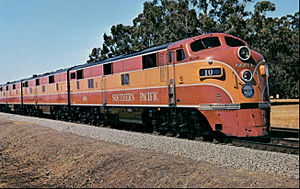
The EMD E5 is a 2,000-horsepower (1,500 kW), A1A-A1A passenger train-hauling diesel locomotive manufactured by Electro-Motive Corporation, and its corporate successor, General Motors' Electro-Motive Division (EMD) of La Grange, Illinois, and produced exclusively for the Chicago, Burlington and Quincy Railroad, and its subsidiaries, during 1940 and 1941. The E5 was distinguished from the otherwise very similar E3, E4 and E6 by being clad in polished stainless steel to match the Burlington's Zephyr trains. It also featured unique small grill-like ornamentation on both sides of the upper headlight. Like the other models in the E-series, the E5 had a sloping “slant nose” and it was equipped with two headlights — a regular stationary headlight above a gyrating Mars signal light. The E5 was the sixth in the EMD E-unit series.
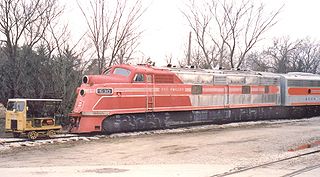
The EMD E6 was a 2,000-horsepower (1,500 kW), A1A-A1A, streamlined passenger train locomotive manufactured by Electro-Motive Corporation, and its corporate successor, General Motors Electro-Motive Division, of La Grange, Illinois. The cab version, E6A, was manufactured from November 1939 to September 1942; 91 were produced. The booster version, E6B, was manufactured from April 1940 to February 1942; 26 were produced. The 2,000-horsepower (1,500 kW) was achieved by putting two 1,000-horsepower (750 kW), 12-cylinder, model 567 engines in the engine compartment. Each engine drove its own electrical generator to power the traction motors. The E6 was the seventh model in a long line of passenger diesels of similar design known as EMD E-units.

The E7 was a 2,000-horsepower (1,500 kW), A1A-A1A passenger train locomotive built by General Motors' Electro-Motive Division of La Grange, Illinois. 428 cab versions, or E7As, were built from February 1945 to April 1949; 82 booster E7Bs were built from March 1945 to July 1948. The 2,000 hp came from two 12 cylinder model 567A engines. Each engine drove its own electrical generator to power the two traction motors on one truck. The E7 was the eighth model in a line of passenger diesels of similar design known as EMD E-units, and it became the best selling E model upon its introduction.
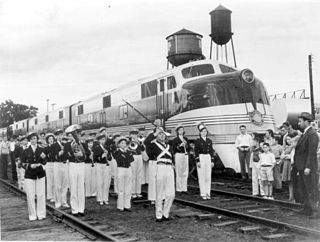
The EMC E4 was a 2,000 horsepower (1,500 kW), A1A-A1A passenger train-hauling diesel locomotive built by the Electro-Motive Corporation of La Grange, Illinois. All were built for the Seaboard Air Line Railway. The E4 was the fifth model in a long line of passenger diesels of similar design known as EMD E-units.

The EMC E3 is a 2,000 horsepower (1,500 kW), A1A-A1A passenger train locomotive that was manufactured by Electro-Motive Corporation of La Grange, Illinois. The EMC demonstrator #822 was released from La Grange for test on September 12, 1938. The cab version, or E3A, was manufactured from September 1938 to June 1940, and 17 were produced. The booster version, or E3B, was manufactured in March 1939 and September 1939, and 2 were produced. The 2,000 hp (1,500 kW) was achieved by putting two 1,000 horsepower (750 kW), 12-cylinder, model 567 engines in the engine compartment. Each engine drove its own electrical generator to power the traction motors. The E3 was the fourth model in a long line of passenger diesels of similar design known as EMD E-units.

The EMD E8 is a 2,250-horsepower (1,678 kW), A1A-A1A passenger-train locomotive built by General Motors' Electro-Motive Division (EMD) of La Grange, Illinois. A total of 450 cab versions, or E8As, were built from August 1949 to January 1954, 447 for the U.S. and 3 for Canada. 46 E8Bs were built from December 1949 to January 1954, all for the U.S. The 2,250 hp came from two 12 cylinder model 567B engines, each driving a generator to power the two traction motors on one truck. The E8 was the ninth model in the line of passenger diesels of similar design known as EMD E-units. Starting in September 1953, a total of 21 E8As were built which used either the 567BC or 567C engines.

The E9 is a 2,400-horsepower (1,790 kW), A1A-A1A passenger train-hauling diesel locomotive built by General Motors' Electro-Motive Division of La Grange, Illinois, between April 1954 and January 1964. 100 cab-equipped A units were produced and 44 cabless booster B units, all for service in the United States. The E9 was the tenth and last model of EMD E-unit and differed from the earlier E8 as built only by the newer engines and a different, flusher-fitting mounting for the headlight glass, the latter being the only visible difference. Since some E8s were fitted with this, it is not a reliable way to distinguish the two. The E9 has two 1,200 hp (895 kW), V12 model 567C engines, each engine driving one generator to power two traction motors.

The EMC E2 was an American passenger-train diesel locomotive which as a single unit developed 1,800 horsepower (1,300 kW), from two (2) 900 horsepower (670 kW) prime movers. These locomotives were typically operated as a unit set or ; where the three unit lashup developed 5400 horsepower. This was almost the ideal horsepower required for the tonnage of a 15 - 18 car passenger train, operated over the ruling grades of virtually all of the mileage between major American cities. The units were of the A1A-A1A wheel arrangement, and manufactured by Electro-Motive Corporation (EMC), later Electro-Motive Diesel (EMD) of La Grange, Illinois.
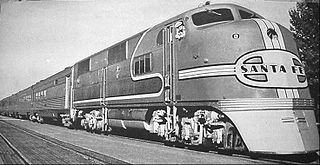
The EMC E1 was an early passenger-train diesel locomotive developing 1,800 hp, with an A1A-A1A wheel arrangement, and manufactured by Electro-Motive Corporation of La Grange, Illinois. They were built during 1937 and 1938 for the Atchison, Topeka and Santa Fe Railway for a new generation of diesel-powered streamlined trains. 8 cab-equipped lead A units and three cabless booster B units were built. The initial three locomotives were AB pairs built to haul the Santa Fe's Super Chief diesel streamliners, while the others were built as single A units to haul shorter trains. The locomotives were diesel-electrics with two 900 hp (670 kW) Winton 201-A engines each, with each engine driving its own generator to power the traction motors. The E1 was the second model in a long line of passenger diesels of similar design known as EMD E-units. All Winton 201A-engined Santa Fe passenger units, including the E1s, were extensively rebuilt into the 80-class E8M engines in 1952–53. These were similar to production E8 models, but derated to 2,000 hp so as not to burn out the early traction (axle) motors.

The EMC EA/EB is an early passenger train-hauling diesel locomotive built from May 16, 1937, to 1938 by Electro-Motive Corporation of La Grange, Illinois for the Baltimore and Ohio Railroad. They were the first model in a long line of passenger diesels of similar design known as EMD E-units. Each locomotive unit developed 1,800 horsepower (1,300 kW) from two 900 hp (670 kW) Winton 201-A diesel engines, driving the wheels through an electric transmission—the generator driven by each engine provided current for traction motors. The locomotives were of A1A-A1A wheel arrangement—two three-axle trucks of which only the outer two axles were powered. Six two-unit 3,600 hp (2,700 kW) locomotives were produced, each consisting of a lead cab-equipped EA A unit and a cabless booster EB B unit. They were numbered 51 through 56; the A units bore the bare number and the B units the number followed by 'X'.
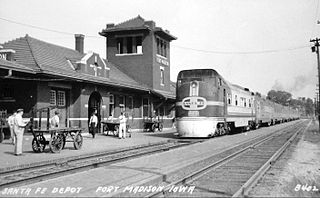
Electro-Motive Corporation produced five 1800 hp B-B experimental passenger train-hauling diesel locomotives in 1935; two company-owned demonstrators, #511 and #512, the Baltimore and Ohio Railroad's #50, and two units for the Atchison, Topeka and Santa Fe Railway, Diesel Locomotive #1. The twin engine power unit layout and multiple unit control systems developed with the B-B locomotives were soon adopted for other locomotives such as the Burlington Route's Zephyr locomotives built by the Budd Company in 1936 and EMC's own EMD E-units introduced in 1937. The B-B locomotives worked as proof-of-concept demonstrators for diesel power with the service loads of full size trains, breaking out of its niche powering the smaller custom Streamliners.

The General Pershing Zephyr was the ninth of the Chicago, Burlington & Quincy Railroad's Zephyr streamliners, and the last built as an integrated streamliner rather than a train hauled by an EMD E-unit diesel locomotive. It was constructed in 1939 with bodywork and passenger cars by Budd Company and diesel engine, electric transmission, power truck, and other locomotive equipment by General Motors Electro-Motive Corporation. Because its intended Kansas City to St Louis route passed near the birthplace and boyhood home of famous World War I General John J. Pershing, the train was named after him. The power car was named Silver Charger, after Pershing's horse Charger, while the passenger cars were named after United States Army badges of rank—Silver Leaf, Silver Eagle, and Silver Star.

The Union Pacific Railroad's M-10003, M-10004, M-10005, and M-10006 were four identical streamlined 2-car power car diesel-electric train sets delivered in May, June, and July 1936 from Pullman-Standard, with prime movers from the Winton Engine Corporation of General Motors and General Electric generators, control equipment and traction motors. One was for the City of San Francisco, two were for the City of Denver, and one was a spare set intended for both routes. In 1939, M-10004 was split and converted into additional boosters for the other sets, now renumbered CD-05, CD-06, and CD-07, all running on the City of Denver. The M-10001 power car became the other third booster. In this form, the three power sets ran until they were replaced by E8 locomotives in 1953, at which point they were scrapped.
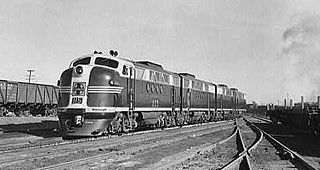
The EMD FT is a 1,350-horsepower (1,010 kW) diesel-electric locomotive that was produced between March 1939 and November 1945, by General Motors' Electro-Motive Corporation (EMC), later known as GM Electro-Motive Division (EMD). The "F" stood for Fourteen Hundred (1400) horsepower and the "T" for Twin, as it came standard in a two-unit set. The design was developed from the TA model built for the C,RI&P in 1937, and was similar in cylinder count, axle count, length, and layout. All told 555 cab-equipped ”A” units were built, along with 541 cabless booster or ”B” units, for a grand total of 1,096 units. The locomotives were all sold to customers in the United States. It was the first model in EMD's very successful F-unit series of cab unit freight diesels and was the locomotive that convinced many U.S. railroads that the diesel-electric freight locomotive was the future. Many rail historians consider the FT one of the most important locomotive models of all time.

EMD F-units are a line of diesel-electric locomotives produced between November 1939 and November 1960 by General Motors Electro-Motive Division and General Motors-Diesel Division. Final assembly for all F-units was at the GM-EMD plant at La Grange, Illinois, and the GMDD plant in London, Ontario. They were sold to railroads throughout the United States, Canada and Mexico, and a few were exported to Saudi Arabia. The term F-unit refers to the model numbers given to each successive type, all of which began with the letter F. The F originally meant "fourteen", as in 1,400 horsepower (1,000 kW), not "freight". Longer EMD E-units for passenger service had twin 900-horsepower (670 kW) diesel engines. The E meant "eighteen" as in 1,800 horsepower (1,300 kW). Similarly, for early model EMD switchers, S meant "six hundred" and N meant "nine hundred horsepower".
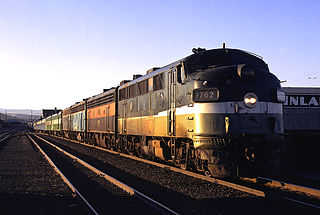
The EMD F3 is a 1,500-horsepower (1,100 kW) B-B freight- and passenger-hauling carbody diesel locomotive produced between July 1945 and February 1949 by General Motors’ Electro-Motive Division. Final assembly was at GM-EMD's La Grange, Illinois plant. A total of 1,111 cab-equipped lead A units and 696 cabless booster B units were built.

In North American railroad terminology, a cab unit is a railroad locomotive with its own cab and controls.

The EMD F9 is a 1,750 horsepower (1,300 kW) Diesel-electric locomotive produced between February 1953 and May 1960 by the Electro-Motive Division of General Motors (EMD) and General Motors Diesel (GMD). It succeeded the F7 model in GM-EMD's F-unit sequence. Final assembly was at GM-EMD's La Grange, Illinois plant. The F9 was also built in Canada by General Motors Diesel at their London, Ontario plant. A total of 101 cab-equipped lead A units and 156 cabless booster B units were built. The F9 was the fifth model in GM-EMD's highly successful "F" series of cab unit diesel locomotives.
Early Electro-Motive Corporation switcher locomotives were built with Winton 201-A engines. A total of 175 were built between February 1935 and January 1939. Two main series of locomotives were built, distinguished by engine size and output: the straight-8, 600 hp (450 kW) 'S' series, and the V12, 900 hp (670 kW) 'N' series. Both were offered with either one-piece cast underframes from General Steel Castings of Granite City, Illinois, denoted by 'C' after the power identifier, and fabricated, welded underframes built by EMC themselves, denoted by 'W'. This gave four model series: SC, SW, NC and NW. Further developments of the 900 hp (670 kW) models gave model numbers NC1, NC2, NW1, and NW1A, all of which were practically indistinguishable externally from the others, as well as a pair of unique NW4 models for the Missouri Pacific Railroad and a solitary, twin-engined T transfer locomotive model built for the Illinois Central Railroad.

"Bulldog nose" is the nickname given, due to their appearance, to several cab-unit diesel-electric locomotives manufactured by GM-EMD and its licensees from 1939 to 1970. The term originated with EMD F-units, as well as later E-unit models such as the E7, E8, and E9. The bulldog nose design, which has been described as a "cultural icon", consists of two narrow front cab windows, swept back above a protruding nose section, usually with a prominent nose-top mounted headlight. This bore resemblance to a dog's face. It was a blunter and more vertical variation of the early "slant nose" style, which featured a more sloped front and often less protruding headlight. Examples of this included the EMC E1.
